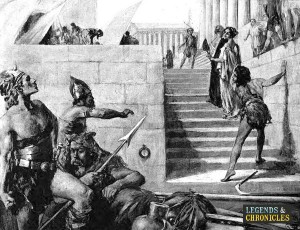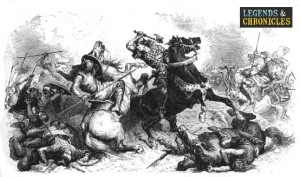Germanic Warriors
The ancient Germanic warriors were strong, often rough around the edges and considered barbaric in attitude, fighting style and their dress by some, although this is in reality far from true. However one fact that is true is that the Germanic warriors of northern Europe were truly fierce warriors, and were collectively comprised of ancient tribes that made up what we consider the Germanic warriors. The Franks, Ostogoths, Visigoths, Burgundians, Angles, Saxons, Lombards and the Vandals among others are some of the commonly known Germanic tribes from history.
The Germanic warrior in their tribe unit would be part of a simple political structure and family and group hierarchy. The ancient Germanic warriors would be led by one chief, and their existence was largely based on their life as a group of nomadic warriors. The Germanic warriors and tribes where from many of today’s modern northern European countries, including England, Scotland, Norway, Sweden, Iceland, Denmark, Austria and Germany among many others.
The term Germanic was actually assigned to these groups of people by the Romans, as they tried to classify the tribes, sometimes the barbaric tribes of Northern Europe. The term Germanic literally translates into ‘Spear Man’ where the spear was the common weapon of the Germanic man and warrior of the time. The Germanic groups were also defined by their use of language, which were all Indo-European and shared similar traits. So while the Germanic warriors of ancient history did share many similarities at the time, its important to note that each tribe and group would have its own unique traits, traditions, and individual fighting styles.
The Romans and the Germanic Warriors
The history of the Romans and the Germanic warriors and tribes is quite legendary, both sides had relationships with each other, incorporating alliances, treaties, and eventually war, tempestuous would be a good way to describe the Roman, Germanic relationship.
The Romans viewed themselves as far superior both in culture, society and lifestyle, than the Germanic warriors. In many ways the Romans were much more barbaric, blood thirsty and megalomaniac than the Germanic tribes, even thought they appeared to be much more civilised and organised.
Classes and Hierarchy with the Germanic warriors
The Germanic warriors and their society were governed by the worth of every person and possessions, and was known as Weregild. The most common Germanic warriors would have been what was coined as a Free Man, which meant just that, the Germanic free man was a servent to no one. However the Germanic warrior would still be bound by certain laws of society, crimes were not tolerated and while punishments were rare, banishment from a tribe was an option.
The Germanic warriors would have the right as free men to vote on their own king, a rule which allowed the general consensus to rule, and more than likely one of the reasons the Germanic warriors were so fierce in battle. The king they had chose was more likely to be a king they were likely to fight, and even die for.
The weapons of the Germanic Warriors
The Germanic warrior weaponry was built on the backbone of the spear, every free man Germanic warrior would carry a spear, which had many uses in combat. In combination with a shield the spear could be used offensively or defensively and would be the go-to weapon choice.
In addition nearly all Germanic warriors carried a sword and smaller blades, for close quarter fighting, which the Germanic warriors were typically excellent at, adding passion and power to what they may have lacked in finesse and poise.
Depending on their tribe the weaponry of the Germanic warrior could vary quite a lot, the Alamannic warrior for example would also carry an axe along with their spear and sword, adding more weight and devastation to their melee presence. The Visigoth Germanic warriors would typically carry an array of spears, some throwing some standing, and mounted Germanic warriors like a horseback riding Lombard would even carry a lance into combat, giving them greater range and height in battle.
Armour and clothing of the Germanic warriors
Germanic warrior armour and clothing was truly a mix of styles and equipment. Due to the multiple Germanic tribes and groups, its hard to pinpoint down an exact uniform that the Germanic warriors wore into battle. Different groups had variations on a similar theme, and even in individual groups there were different levels of equipment an individual Germanic warrior might own.
Common to every warrior was a shield. Each Germanic warrior would use a shield as their primary defence, and was used in combination with swords, spears and shorter range melee weapons, although the spear was typically the most common weapon used.
Clothing was optional for Germanic warriors, trousers were common if owned, and sometimes a tunic and cloak would worn, but in many cases clothing was often seen a disadvantage especially if the dirty cloth was to infect a wound obtained in battle.
Helmets were typically rare, but some warriors wore them, whether they were their own or that of a past fallen foe from a previous battle. Chain mail had a similar distribution among the Germanic troops, if not slightly more common, and body armour increased in use later in time.
The battle tactics of the Germanic warriors
The Germanic warriors had a fierce reputation, considered as almost barbaric on the battlefield, and their reputation was well earned, these long haired warriors fought with passion, honesty and a modicum of battle tactics.
‘We had heard of the legendary Boar’s Head, the formation employed by the Germanic warriors, we knew that if we were to face them, we might meet our end. Our more experienced figthers had seen it before, they bore the scars of that encounter and we were now more fearful than before. We hoped that in battle maybe the gods would smile down on us and not the Germanics.’
While the Germanic warriors were in no way as tightly knit or organised as the Romans, they did have some battle tactics. They placed large emphasis on individual fighting, but still employed battle lines, like the well known boar’s head formation that was essentially a forward moving triangle filled with suitably equipped and armoured Germanic warriors.
The front of the boars head would be led by the well equipped, well armoured and battle hungry warriors. The armour and typically better weapons afforded them not only more defence but more offence too. Behind this first line of Germanic battle hungry warriors would be more battle savvy fighters, and as we moved further back int eh formation would be the less experienced warriors.
It’s well known the Germanic warriors were ferocious but not necessarily as skilled or organised as some of their foes. The success of a battle would often depend on the heart of the Germanic fighters and the skill of their enemy, and whether their often aggressive battle tactics played out in their favour.
The Germanic warriors in summary
Made of many, and as brave and as savage as they come on the battlefield, the Germanic warriors were not to be trifled with. Considered to be fair and just when not at war, the Germanic warriors were passionate but not always equipped to the standard of their foe. Still they would often succeed in battle, fuelled by their intense drive and heart, the heart of a true Germanic warrior.
‘As we waited for news on what group of Germanic people were awaiting us in battle the next day, we wondered what our scout would find. Would we fight Goths, Visigoths, Lombards or even the Franks. Not that it really mattered, they were all as bloodthirsty as each other on the battlefield, luckily we had our Roman formations to rely on, hopefully they would keep us safe from the vicious Germanic warriors.’

